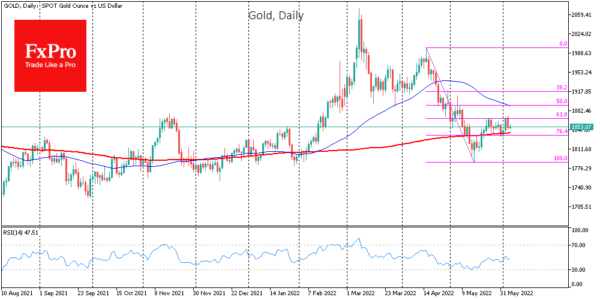Gold lost 1% to $1850 on Friday, declining under pressure from the overall pull from risky assets. For short-term traders, it is also telling that this decline mostly erased the gains of the first few days of the month and prevented the rebound from turning into new upside momentum.
Gold came up against the resistance of sellers on Friday, as it did a fortnight ago, trying to move above the 61.8% Fibonacci retracement line from the highs of April near $2000 to the lows of May, below $1790.
The following potentially significant level is the $1840 area, where the 200-day moving average passes. In early June, the buyers prevented gold from getting below that line, but it makes sense to expect that the bears have entirely abandoned the idea of breaking below it.
It is also interesting that an increase in central bank buying accompanied the fall in the price of gold in April. For April, new data from the World Gold Council showed net purchases by global central banks of 19.4 tonnes after net sales in March.
Central bank purchases should not be taken as a bullish signal for the market as regulators often acted as market stabilisers by selling in the early 2000s during one of the strongest rallies. Uzbekistan (+9.4t), Turkey (+5.6t) and Kazakhstan (+5.3t) were the most substantial buyers of gold. Sales were more modest, with Germany (-0.9t) and Mexico and the Czech Republic (-0.1t each) contributing the most. It will be no surprise if data for May would show an even bigger net buying.
In our view, net purchases of gold by EMs and sales by developed economies indicate a relatively benign financial environment in the global economy. Otherwise, EMs were forced to sell gold to protect their currencies from declines.














